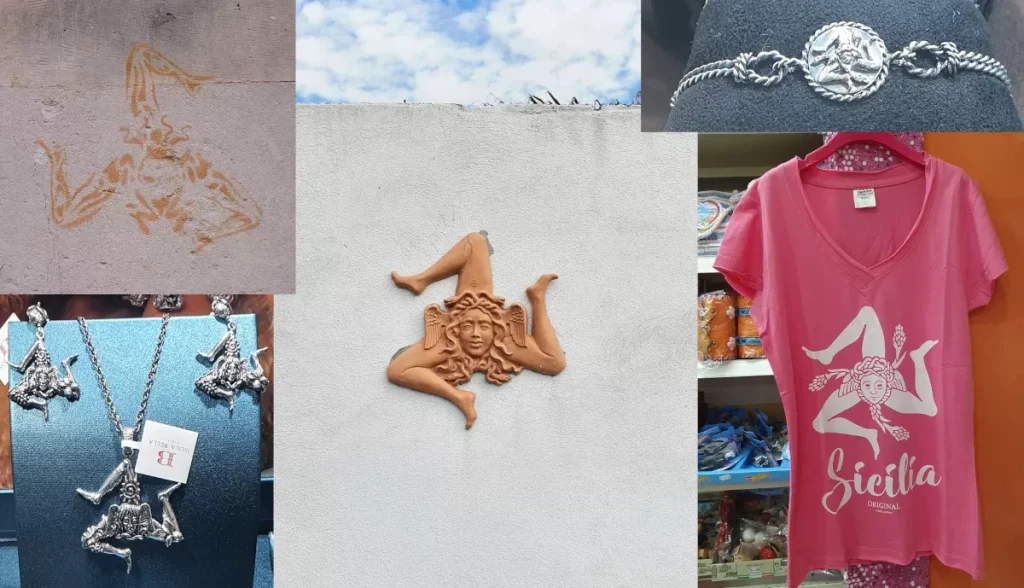The flag of the (autonomous) region of Sicily (one of the 20 regions of Italy) features a decorated woman’s head on a red and yellow background. This flag, as we know it today, dates back to the 13th century. But the history of this symbol is much older.
The colours of the background (red and yellow) stand for the cities of Palermo and Corleone respectively. These two cities were the first to unite in an alliance against the French rule of the time: with the so-called Sicilian Vespers, the revolt against Charles I of Anjou began in Palermo on Easter Monday 1282 (at the time of evening prayer, Vespers), which led to the expulsion of the French from Sicily. The flag flew for the first time during this uprising.
In the middle of the flag you see a trinacria: the head of a woman surrounded by 3 legs. This symbol is not only depicted on the coat of arms of Sicily; as a good luck charm it can be found on houses, ceramics and of course on souvenirs; you can hardly walk a few metres in the cities of Sicily without it catching your eye.

There are different explanations for how this symbol originated; the following is most likely.
Three legs – the triskelion
The three legs are a variation of an ancient symbol, the triskele, which consists of three arcs or legs that move symmetrically away from the centre. The word triskele comes from the Greek and means tripod. Such a tripod can also be found, for example, in the coat of arms of the Isle of Man or the town of Füssen in Bavaria.
The triskele was a religious symbol meant to represent the sun god or his appearance in the form of the three seasons of spring, summer and winter. It was also common in Greece and was printed on coins there. With the colonisation of Sicily by the Greeks, this sign is also found on Sicilian coins (in the 3rd century BC). However, the symbol can be found much earlier in Sicily: The oldest representation was found in western Sicily, in the area of present-day Agrigento, on a terracotta vessel made around 700 BC.
Aufgrund der dreieckigen Form Siziliens wurde dieses Symbol bald zum Symbol Siziliens selbst. It was also the Greeks who gave Sicily the name Trinacria. This word is composed of the Greek words for “three” and “cape” and refers to the three capes at the extreme tips of Sicily:
- Cape Lilibeo in Marsala in western Sicily,
- Cape Passero at the southeast corner,
- Cape Peloro in the northeast.
Medusa, the snaky-haired monster
The head depicted on the flag is a Medusa head. Medusa is a figure from Greek mythology. She was one of the three Gorgons: an ugly, winged monster with snakes instead of hair on her head, who turned anyone who looked into her eyes to stone. According to Ovid, Medusa was once a beautiful woman, but she fell out with the goddess Athena by having fun with Poseidon in a temple of Athena, putting her beauty above the goddess’ beauty. Athena then punished her with her notorious appearance.
Many Greek heroes tried to kill Medusa (she was the only one of the three Gorgons who was mortal) and were petrified; only Perseus succeeded because he got help from the gods. They advised him to do the following: He took a shield with him and instead of looking directly at Medusa, he only looked at her image reflected in the shield. That way he could decapitate them.
He took the severed head of the Medusa with him; it was useful to him a few more times because it turned his enemies into stone. For the same reason, the image of a Medusa’s head was and still is often placed on houses – and precisely on the flag of Sicily. It is supposed to protect the house and its inhabitants from intruders and all evil.
In Roman times, grain ears were added to the Medusa’s head; Sicily was considered the granary of Italy at that time. The Roman family, to which the then Roman province of Sicily was subject, wanted to provide the Roman emperor (and thus oust the incumbent Caesar). She had the ears of corn printed on the coins minted in Sicily to show: Sicily has the grain and therefore also power. However, Caesar got wind of this and sent this family into exile in Macedonia.
Another explanation for the head of Medusa on the flag of Sicily is as follows: just as Medusa petrifies everything with her glowing red eyes, Etna also turns everything to stone with its red lava that bursts out of the craters and buries everything.
So, too, the story of the flag of Sicily eventually leads us to our beloved Etna. And it shows us once again the richness of the tales that entwine around this island and also around the largest and most active volcano in Europe. We will tell you more about it in our blog. See you next time!

